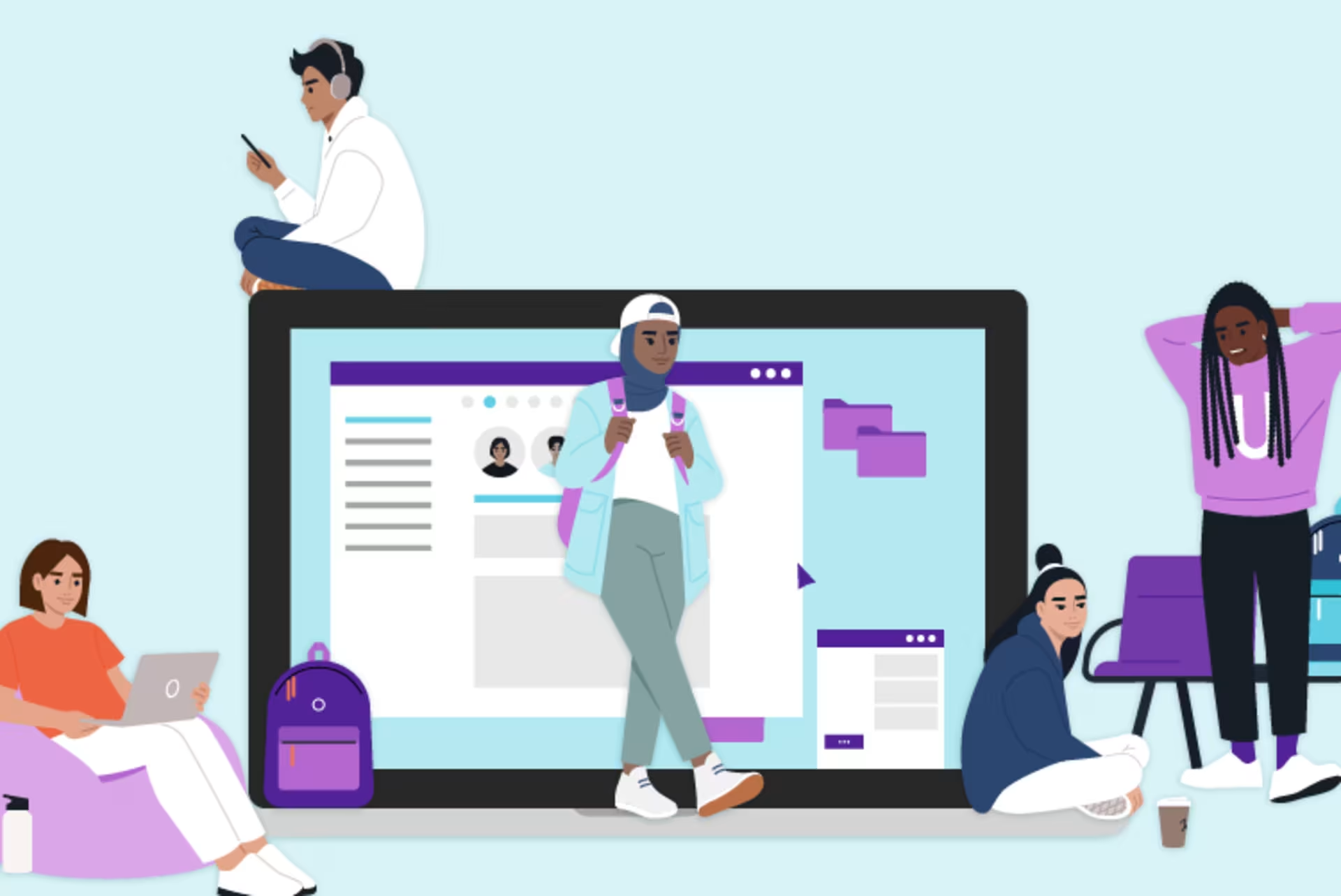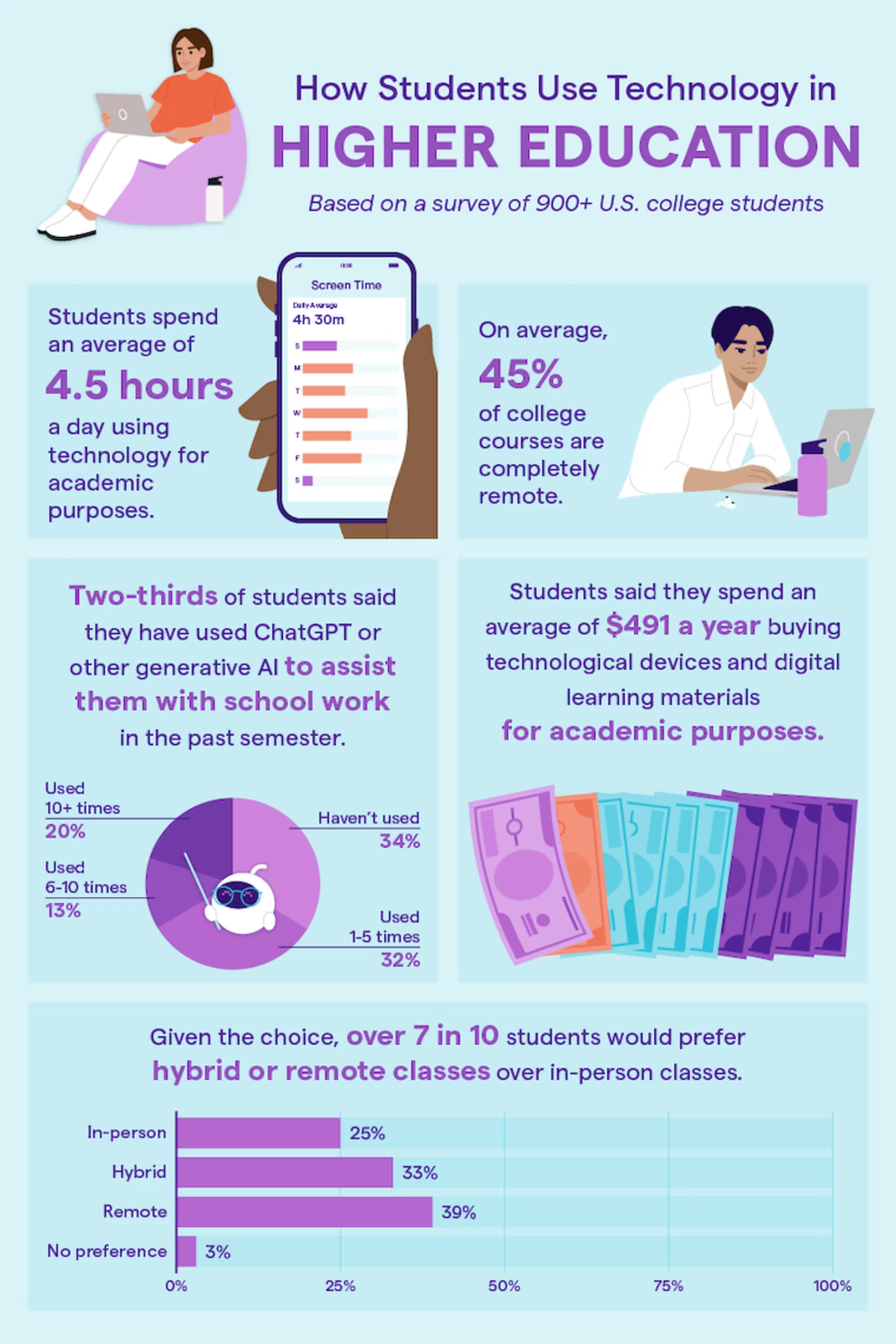Read time 7 minutes
Published on Dec 2, 2024
Read time 7 minutes
Published on Dec 2, 2024
Speak with a University Counselor today.
Approved and verified accurate by the assistant vice president of GCU marketing on Oct. 24, 2024.
The views and opinions expressed in this article are those of the author’s and do not necessarily reflect the official policy or position of Grand Canyon University. Any sources cited were accurate as of the publish date.

As colleges and universities navigate the blend of traditional and digital educational models, student preferences play a crucial role in shaping the future of academic delivery methods. The current data reveals a significant inclination toward digital formats over traditional, in-person methods, reflecting broader trends in technology adoption among college students.(See disclaimer 3) Offering additional learning models that are more flexible and autonomous can better meet the varying needs and schedules of students, ultimately making education more accessible and can foster social mobility.
Remote and hybrid course models have become increasingly prevalent, with 45% of students reporting their courses are completely remote, while 17% are experiencing a hybrid model that combines online and in-person learning. To put this into perspective, only 8% of undergraduate students were enrolled in online courses in 2000.(See disclaimer 4) By the 2015-16 academic school year, this number had increased dramatically, with 43% of undergraduate students taking at least one online class.(See disclaimer 4) The rapid growth in online and hybrid learning, which was even further accelerated by the COVID-19 pandemic, underscores the significant higher education digital transformation toward more flexible and technology-integrated learning models.
Communication preferences among students further emphasize this digital shift. An overwhelming 87% of students prefer emailing their professors over any other form of communication, starkly contrasting with the 11% who favor in-person interactions. It is possible this preference highlights the value placed on the convenience and record-keeping ability of digital communication. Interestingly, male students are slightly more inclined than female students to choose in-person communication, with 14% of males preferring this method compared to 8% of females.
The use of digital resources also extends to course materials, where 66% of students surveyed primarily use digital textbooks. This choice is likely driven by the ease of access and portability that digital textbooks offer.(See disclaimer 5) Additionally, more than half of the students surveyed (55%) prefer to access instructor-assigned readings in a digital format rather than in physical print form.
Testing formats also reflect a similar trend, with 67% of students favoring digital tests over traditional paper-based exams. This preference could be attributed to the perceived convenience, immediate feedback mechanisms and the reduced anxiety associated with digital test formats.(See disclaimer 6)
When considering the overall structure of their academic experience, the students we surveyed showed diverse preferences, as 39% would opt for the majority of their classes to be conducted remotely, 33% favor a hybrid approach and only 25% prefer entirely in-person classes. This data suggests a strong demand for flexibility in learning environments, with a significant portion of the student body appreciating the benefits that remote and hybrid learning models offer.
These survey results show strong favoritism toward online learning tools among students, reflecting a trend that aligns with modern educational preferences. At GCU, we cater to these preferences by providing a variety of learning modalities tailored to student needs, offering a variety of accredited degree programs both online and on our vibrant, collaborative campus. This provides campus-based students with the flexibility and accessibility of online learning while still experiencing the enriching social and academic environment of an on-campus education.
In the ever-evolving landscape of higher education, technology is revolutionizing the way students engage with their academic environments, transforming their daily lives and learning experiences. Imagine a college student today — balancing online classes, collaborating with peers via virtual platforms and leveraging AI-assisted study tools to excel in their courses. This is the reality of the modern-day student.
From remote learning platforms to digital textbooks and online learning tools, the higher education digital transformation is reshaping universities in profound and exciting ways. In this blog, we'll explore how these advancements are not just enhancing learning processes but also redefining what it means to be a student in the digital age.
To thoroughly examine the extensive impact of technology on college students across the United States, Grand Canyon University hosted a nationwide survey targeting undergraduate and graduate students currently attending a variety of higher education institutions to assess various aspects of technology in education. The study examined the impact of technology in the following areas of education: student ownership, usage patterns, preferences and the detailed benefits and challenges encountered by students.
To gain a comprehensive understanding of the role of technology in higher education, Grand Canyon University hosted a nationwide survey, targeting both undergraduate and graduate students attending various higher education institutions. The survey ran March 5-26, 2024 and successfully gathered responses from 962 students, providing some demographic information, a broad spectrum of insights into their technology usage, preferences and challenges faced in their academic pursuits. The survey included a diverse range of questions covering different aspects of technology in education, ensuring a comprehensive analysis of student experiences and perspectives.
The integration of technology in higher education has significantly reshaped the academic space,(See disclaimer 7) eliciting a spectrum of sentiments from students regarding its benefits and challenges. As universities continue to harness digital tools to enhance educational delivery, understanding these views becomes crucial in optimizing student experiences and outcomes.
Our findings showed largely positive benefits of technology in academics, with 89% of students citing improved access to resources and materials as a major advantage. This access helps break down barriers to information and educational content. Additionally, 85% of students value the increased flexibility in learning that technology provides, allowing them to tailor their studies to personal schedules and preferences. Faster grading and feedback are appreciated by 64% of students. This efficiency significantly enhances the learning process, as students can rapidly incorporate feedback into both their ongoing and future assignments, optimizing their performance and learning outcomes.
While technology can offer numerous benefits in education, it's important to acknowledge and address some common challenges. Distraction is a notable issue, with 68% of students finding that digital platforms can sometimes divert their attention from studies. Similarly, 64% of students experience procrastination, often due to the immediate availability of digital resources. Additionally, 49% of students report encountering technical issues or unreliability with online learning tools, which can occasionally disrupt learning and cause significant stress. Recognizing these challenges allows educators and students to develop strategies to mitigate them and make the most of technology advantages in modern education.
At GCU, we understand the crucial role that technology plays in enhancing our students' educational experiences. We are dedicated to tackling common challenges such as distractions, procrastination and technical issues while maximizing the significant benefits that technology can bring, including improved access to resources and greater flexibility in learning.
Through continuous refinement of our digital platforms and enhancement of our student support services, we aim to create a supportive environment where every student can utilize technology for both pursuing personal growth and achieving academic goals.
As technology continues to influence the educational world, it is essential for future educators to master the integration of digital tools into their teaching strategies. If you are interested in discovering how educational technology can transform your classroom, consider enrolling in one of our online teaching degree programs. Our Master of Science in Instructional Technology degree can equip you with the skills to design, develop and implement innovative technology-based learning solutions, helping you prepare creative and impactful instructional materials and training programs.
Other degree programs also exemplify the adaptation of educational practices for the digital era. For instance, our BA in Professional Writing for New Media, MA in Curriculum and Instruction and MS in Instructional Design degree programs all incorporate advanced digital technologies and innovative approaches to address contemporary educational needs. These programs emphasize the importance of technical skills and offer curricula designed to help prepare you for the evolving demands of the digital landscape.

The digital realm in higher education has become a fundamental part of the student experience, as evidenced by the near-universal ownership of laptops or desktop computers among college students (99%), according to our survey.
Beyond computers, the array of technology devices students own is diverse and extensive. We discovered over 60% of students possess a mobile phone and headphones as well as a tablet and have access to high-speed internet, creating a connected and multifaceted digital toolkit. Indeed, 65% of students report using four different technological devices for their coursework, with a notable 23% utilizing up to six different tech tools. This integration of technology into daily academic life is further highlighted by students spending an average of 4.5 hours per day using digital technology for educational purposes.
Financially, students invest significantly in these tools. The survey found that students are spending an average of $491 annually on technological devices and digital learning materials. This investment isn't just about convenience — it's essential. According to our study, on average, 74% of students’ academic assignments and tests are now completed digitally. The shift toward digital mediums is also reflected in students' preferences for note-taking, with 41% indicating that typing on a computer is their primary method. This method is particularly prevalent among male students (46%), in contrast to 42% of female students who prefer writing on paper.
Advancements in technology, like artificial intelligence and virtual reality, can offer opportunities to create more tailored, personalized educational experiences which ultimately enhance and improve learning outcomes for many students. Imagine a world where students collaborate with AI tools like ChatGPT, receiving instant feedback, brainstorming ideas and refining their work with unparalleled precision. This isn't a distant dream — it's the reality for today's college students.(See disclaimer 1)More than 20% of students reported that their professors have tasked students with using AI tools like ChatGPT to assist with preparation for assignments or tests.
AI engagement is even more pronounced in usage statistics, where 66% of students have utilized AI tools within the past semester to aid their academic work. Notably, 20% of these students have turned to ChatGPT ten or more times in a semester alone, indicating a significant reliance on AI for their studies. This trend is slightly more common among male students, with 70% using AI to assist with their studies compared to 62% of female students.
These statistics not only illustrate how the scope of academic support can be greatly expanded through the adoption of new technologies and the pervasiveness of technology in modern education, they also highlight the shifting dynamics of academic practices. Ultimately, they underscore the growing dependence on online learning tools for educational growth.(See disclaimer 2) This shift has also required institutions to create clear AI policies and implement them into their student handbooks.